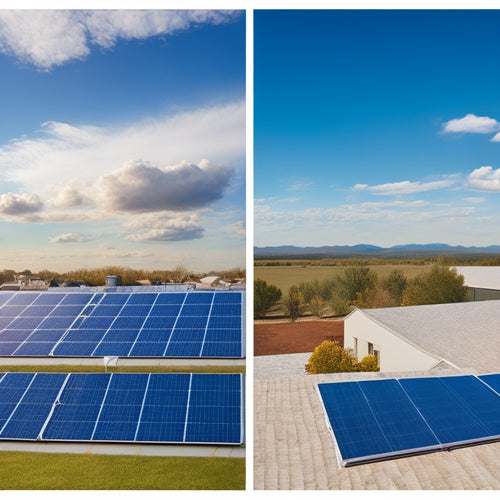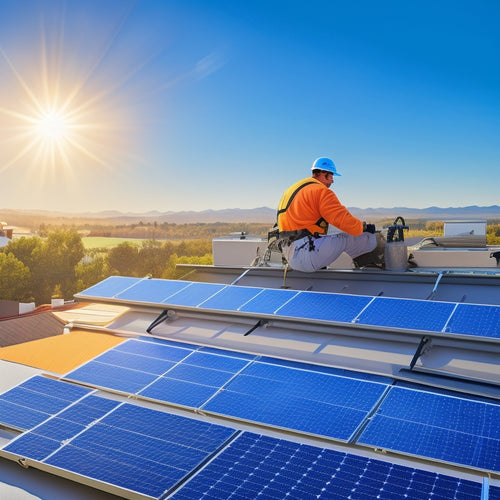
What Are the Most Energy-Efficient Energy Saving Light Bulbs?
Share
When it comes to reducing your energy consumption and environmental footprint, choosing the right light bulb makes all the difference, and you'll find that LED bulbs, CFLs, halogen bulbs, and smart bulbs with Energy Star certification offer the most significant energy savings and longest lifetimes. LED bulbs, for instance, use up to 90% less power than traditional bulbs and last up to 25,000 hours. CFLs, on the other hand, use about 75% less energy and can last up to 10,000 hours. As you investigate these options, you'll uncover specific features and benefits that will help you make an informed decision about which energy-efficient light bulb is right for you.
Key Takeaways
- LED bulbs use up to 90% less power than traditional bulbs, offering significant cost savings and reduced energy consumption.
- CFLs utilize up to 75% less energy than incandescent bulbs, lasting up to 10,000 hours and providing cost-effective lighting solutions.
- Energy Star certified bulbs meet strict energy efficiency standards, using up to 90% less energy and lasting up to 25 times longer than traditional options.
- Xenon bulbs employ electric discharge for light production, making them more energy-efficient than traditional bulbs.
- Smart bulbs enable remote control, smart dimming, and scheduling, facilitating energy conservation and informed energy-saving decisions.
Types of Energy-Efficient Bulbs
As the quest for energy efficiency illuminates the path to a sustainable future, the spotlight falls on various types of bulbs that shine brighter while consuming less power.
You're likely familiar with incandescent bulbs, but you're looking for incandescent alternatives that can help reduce your energy consumption. One option is halogen bulbs, which use up to 30% less energy than traditional incandescent bulbs while maintaining a similar brightness and color temperature.
Another option is compact fluorescent lamps (CFLs), which use up to 75% less energy and can last up to 10,000 hours, considerably longer than the 1,000-hour lifespan of incandescent bulbs.
You may also consider xenon bulbs, which use an electric discharge to produce light, making them more energy-efficient than traditional bulbs.
These alternatives not only reduce your energy consumption but also have a longer bulb lifespan, making them a cost-effective option in the long run.
LED Bulb Energy Efficiency
You've examined halogen, CFL, and xenon bulbs as alternatives to traditional incandescent bulbs, but another option stands out for its outstanding energy efficiency: LED bulbs.
LEDs use considerably less energy than their counterparts, with some models consuming up to 90% less power. This extraordinary energy efficiency translates to substantial cost savings over time.
One of the key LED lifespan benefits is their impressive longevity. With an average lifespan of 15,000 to 25,000 hours, LEDs far outlast traditional bulbs, which typically last around 1,000 to 2,000 hours.
This means you'll replace LEDs much less frequently, reducing waste and saving you time and money.
LED color temperature is another important consideration. LEDs are available in a range of color temperatures, from warm white (2700K-3000K) to cool white (3500K-5000K) and daylight (5000K-6500K).
This allows you to choose the perfect tone for your space, whether you prefer a cozy ambiance or a bright, energizing atmosphere.
With their unbeatable energy efficiency, long lifespan, and versatility, LED bulbs are an attractive option for those seeking to reduce their environmental footprint and energy bills.
CFL Bulb Energy Savings
Compact fluorescent lamps (CFLs) are another energy-efficient option for homeowners looking to reduce their energy consumption. You can expect CFL bulbs to last up to 10,000 hours, which is considerably longer than traditional incandescent bulbs. This extended CFL bulb lifespan translates to fewer replacements and lower maintenance costs.
Additionally, CFLs use about 75% less energy than incandescent bulbs, making them a cost-effective choice.
When it comes to brightness, CFL bulbs are available in a range of wattages and lumens. You can choose a CFL bulb that matches the brightness of your traditional bulb, ensuring you don't sacrifice light quality for energy efficiency. For example, a 13-watt CFL bulb can provide the same brightness as a 60-watt incandescent bulb.
With CFLs, you can enjoy considerable energy savings without compromising on performance. By switching to CFLs, you'll not only reduce your energy consumption but also contribute to a more sustainable future.
Halogen Bulb Energy Comparison
Halogen bulbs, another popular energy-efficient option, operate at a higher temperature than traditional incandescent bulbs, producing a brighter, whiter light. This is because they've a tungsten filament that's contained within a halogen gas, which helps to redeposit evaporated tungsten back onto the filament, extending its lifespan.
When comparing halogen bulbs to other energy-efficient options, you'll find they've some unique advantages. Here are a few key benefits:
- Halogen bulbs are often less expensive upfront compared to CFLs and LEDs
- They've a longer lifespan than traditional incandescent bulbs, typically lasting around 2,000 hours
- Halogen bulbs are dimmable, making them a great option for spaces where you want more control over the lighting
- They produce a bright, white light with a high color temperature, making them ideal for task lighting
- Halogen bulbs are widely available and can be used in most standard light fixtures
Smart Bulb Energy Features
Within the domain of energy-efficient lighting, smart bulbs offer a unique set of features that set them apart from their counterparts. One of the primary advantages of smart bulbs is their ability to be controlled remotely, allowing you to adjust the lighting in your home from the comfort of your couch or even when you're not at home. This feature is especially useful when you're going out of town and want to give the illusion that someone is still at home.
Smart bulbs also offer smart dimming, which enables you to adjust the brightness of the light to suit your mood or the time of day. This feature not only enhances the ambiance of your home but also helps you conserve energy.
Here is a summary of some key smart bulb energy features:
| Feature | Description | Benefits |
|---|---|---|
| Remote Control | Adjust lighting remotely | Convenience, energy savings |
| Smart Dimming | Adjust brightness to suit mood/time of day | Ambiance, energy savings |
| Scheduling | Set schedules for lighting | Convenience, energy savings |
Energy Star Certified Options
Your home's lighting setup is about to get a major enhancement in energy efficiency with Energy Star certified options.
As you shift to eco-friendly options, you'll greatly reduce energy consumption. Energy Star is a program run by the U.S. Environmental Protection Agency that helps consumers identify energy-efficient products.
When shopping for Energy Star certified light bulbs, look for the following benefits:
- Uses up to 90% less energy than traditional incandescent bulbs
- Lasts up to 25 times longer than traditional incandescent bulbs
- Meets strict energy efficiency guidelines set by the EPA
- Is produced by manufacturers who meet Energy Star program requirements
- Helps reduce greenhouse gas emissions from power plants
Frequently Asked Questions
Can I Use Energy-Efficient Bulbs With Dimmer Switches?
You can use energy-efficient bulbs with dimmer switches, but check for dimmer compatibility first, as some LEDs may flicker or not dim properly, affecting bulb brightness; look for bulbs specifically labeled as "dimmable" for best performance.
Do Energy-Efficient Bulbs Affect the Color of Light Emitted?
You're probably thinking energy-efficient bulbs sacrifice light quality, but surprisingly, they don't! You'll get consistent color temperature, and the light quality remains unaffected, ensuring you receive the same warm or cool tones you're accustomed to, without compromising energy efficiency.
Can I Recycle Energy-Efficient Bulbs at Local Recycling Centers?
You'll need to check with your local recycling centers about bulb disposal, as recycling options vary; some accept CFLs and LEDs, while others don't, so it's important to call ahead and confirm their specific guidelines.
Are Energy-Efficient Bulbs Resistant to Extreme Temperatures?
As you venture into the era of enlightenment, you'll find energy-efficient bulbs aren't easily fazed by extreme temperatures. They're designed to maintain ideal temperature performance, ensuring a longer bulb lifespan, so you can bask in their radiant glow without worrying about their durability.
Do Energy-Efficient Bulbs Attract Fewer Insects Than Traditional Bulbs?
You'll find that energy-efficient bulbs, particularly those with a narrower light range, attract fewer insects than traditional bulbs, as they emit less UV and heat, reducing insect attraction and making your outdoor spaces more comfortable.
Conclusion
As you switch to energy-efficient light bulbs, remember that every watt counts. The choices are clear: LED bulbs shine brightest with their unparalleled energy efficiency, CFLs offer a cost-effective alternative, and halogen bulbs provide a dimmer, yet still energy-conscious, option. But, the real breakthrough lies in smart bulbs, which can be controlled and optimized for maximum energy savings. With Energy Star certified options, the path to a more sustainable future is illuminated, and the question becomes, what are you waiting for to flip the switch?
Related Posts
-

Master Advanced Solar Panel Design Online for Free
You can master advanced solar panel design online for free by leveraging specialized courses and training platforms, ...
-

Tracking Solar Panels Vs Fixed Panels Cost Savings
When considering solar panel options, you'll want to weigh the cost savings of tracking solar panels versus fixed pan...
-

3 Essential Steps for Solar Electricity Installation
To guarantee a successful solar electricity installation, you'll need to follow three essential steps. First, assess ...


